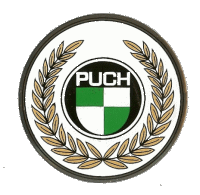
Austrian 800cc Four
Puch P800 1936 – 1938
La motos austriacas Puch son conocidas por sus modelos con motores de dos tiempos monocilíndricas con doble pistón, sin embargo también fabricaron el poco conocido modelo P800 de cuatro cilindros válvulas laterales de 800 cc.
EL P800 se diseñó a pedido del gobierno de Austria, con el fin de dotar al ejército austriaco de una moto robusta, capaz de transportar con un sidecar tres personas por los pasos de los Alpes austriacos y superar pendientes de 30°.
Contrariamente a las apariencias, el motor no es un cuatro cilindros boxer, sino un cuatro cilindros en V muy abierta a 170° dispuestos transversalmente. La cilindrada era de 792 cc (60 x 70), inicalmente con relación de compresión de 5 a 1 y luego (con el remplazo de válvulas por otras de mayor diámetro) elevada a 6 a 1, mientras que la modesta potencia máxima del motor pasó de 18 a 20 HP a 4000 rpm. Sin embargo el torque, incluso a baja velocidad era respetable, condición ideal para transitar con un sidecar.
Un carburador invertido, especialmente diseñado por Puch (que en 1937 se cambió por un Solex IFP CV), iba montado en la tapa de distribución, alimentando ambos bloques de cilindros por unos cortos tubos de admisión integrados en la misma tapa. Así, gracias al diseño avanzado tanto de la cámara de combustión como del tren de válvulas y con el uso del carburador de flujo descendente se lograba un alto rendimiento y una excelente aceleración con un consumo de combustible económico (4,5 Lt/100 km solo y 6,5 Lt/100 km con sidecar)
El conjunto en bloque de motor y caja tenía un cigüeñal forjado en una sola pieza y la lubricación era por bomba de circulación del tipo automotor. Una dinamo iba colocada detrás del motor y una bobina proporcionaba la alta tensión a las bujías a través de un distribuidor con cuatro salidas.
El control de la caja de cambios de cuatro velocidades era por palanca de mano. Curiosamente, la transmisión secundaria es por cadena y, siguiendo la tradición Puch, el embrague multidisco se encontraba en la rueda trasera.
El cuadro era de doble cuna con horquilla de paralelogramo deformable y el depósito de combustible era de 15 litros con reserva (luego incrementado a 17 litros)
A pesar de sus 195 Kg alcanzaba una velocidad máxima de 125 Km/h (95 Km/h con sidecar). Diseñado principalmente para la policía y los militares, estas motos también fueron vendidas a particulares para usar en zonas montañosas y terrenos difíciles. Normalmente eran pintadas en negro con líneas rojas y blancas para uso civil mientras que los modelos para las autoridades se envíaban con pintura gris.
La venta a los particulares fue debido a la crisis económica global y a que la exportación a Alemania era imposible debido a la fuerte competencia de Zündapp y BMW. La producción de las Puch 800 se detuvo después que Austria fue anexada por la Alemania nazi siendo fabricados solo 550 ejemplares entre 1936 y 1938.
The four-cylinder 800cc side-valve P800 was designed at the request of the Austrian government in order to equip the Austrian army with a sturdy motorcycle capable of transporting three people through the Austrian Alps and climbing 30 ° slopes with a sidecar attached.
Contrary to appearances, the engine is not a four-cylinder boxer; it is a 170° V4 arranged transversely.
With a displacement of 792cc (60 x 70mm), initially it had a compression ratio of 5 to 1 which was increased to 6 to 1 and fitted with larger valves. The relatively modest maximum power of the engine increased from 18 to 20 HP at 4000 rpm. The low-speed torque was quite respectable, ideal for sidecar use.
An inverted carburetor, specially designed by Puch (which in 1937 was replaced by a Solex IFP CV), was mounted on the valve cover which had integral short inductin tracts which fed both sides of the engine. Advanced design of both the combustion chamber and the valve train and with the use of a downdraft carburetor achieved high performance and excellent acceleration along with very good fuel economy - 4.5 Lt / 100 km, and 6.5 Lt / 100 km with sidecar.
The unit construction engine and gearbox housed a crankshaft forged in a single piece and lubrication was by an automotive-style oil pump. A dynamo was placed behind the engine and a coil provided the high voltage to the spark plugs through a distributor with four HT leads.
The control of the four-speed gearbox was by hand lever. The final drive was by chain and the multi-plate clutch was in the rear wheel. This was a feature on many Puchs, for instance the GS350 and the S4 of 1934-42.
The frame was double cradle with deformable parallelogram fork and the fuel tank was 15 liters with reserve (later increased to 17 liters)
In spite of its 195 Kg it reached a maximum speed of 125 Km / h (95 Km / h with sidecar).
Designed primarily for the police and the military, these bikes were also sold to individuals for use in mountainous areas and difficult terrain. Normally they were painted in black with red and white lines for civil use while the models for the authorities were sent with gray paint.
The sale to individuals was due to the global economic crisis and that export to Germany was impossible due to strong competition from Zündapp and BMW. The production of the Puch 800 stopped after Austria was annexed by Nazi Germany with only 550 copies being manufactured between 1936 and 1938. It is believed that 90 of these remain.
See also:
Source: Sergio Scalerandi